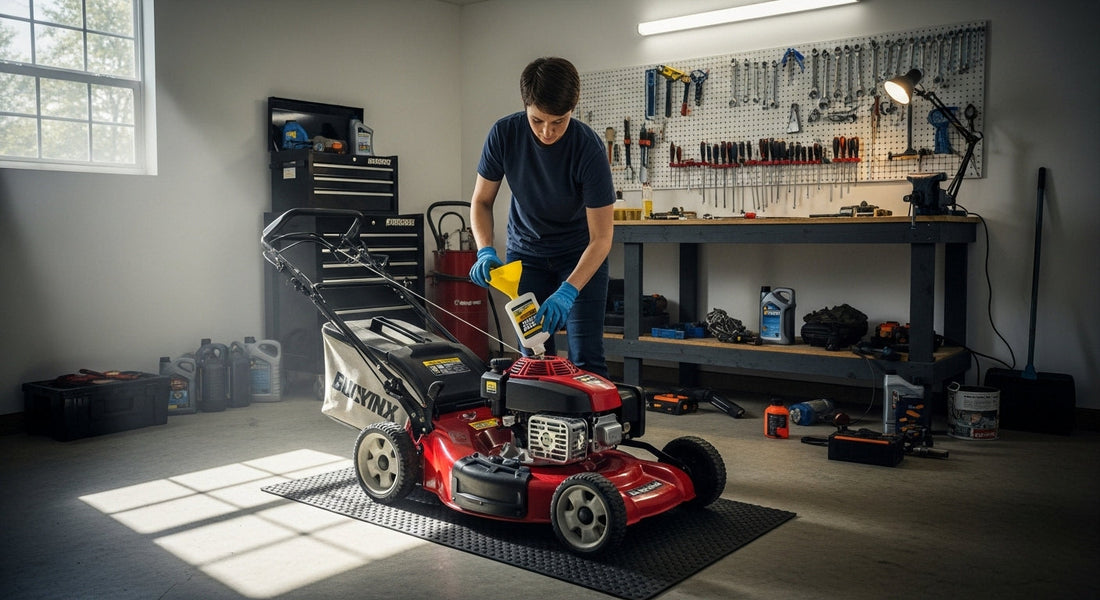
How to Winterize Your Gas-Powered Equipment (Mower, Trimmer, Blower)
Share

As the gardening season winds down and the temperatures drop, there's one final, crucial task before you hang up your tools for the winter: properly preparing your gas-powered equipment for storage. How to winterize a lawn mower, trimmer, leaf blower, and other power tools is arguably the most critical small engine maintenance task of the year. A little work now saves you from a big headache (and potentially expensive repairs) come springtime. Untreated gasoline left in an engine over the winter can degrade, gum up carburetors, and cause serious starting problems.
The Three Most Important Steps
While there are several things you can do, these three steps address the most common and damaging issues associated with long-term storage.
A. Step 1: The Fuel System (The Most Critical Step)
This is where most storage-related problems occur. Modern gasoline, especially ethanol blends, can go stale in just a few months, leaving behind gummy deposits that clog fuel lines and carburetors. You have two main options:
-
Use Fuel Stabilizer: The easiest and most recommended method is to add a quality gas stabilizer for winter to a nearly full tank of fresh gasoline. Follow the stabilizer's instructions for the correct ratio. Once added, run the engine for 5-10 minutes. This circulates the stabilized fuel throughout the entire system, protecting it from degradation. Leaving the tank full (with stabilized fuel) also prevents moisture condensation inside the tank.
-
Run it Dry: Alternatively, you can run the engine completely out of gas. This ensures there's no fuel left to degrade, but it can leave some internal carburetor parts dry and potentially vulnerable to corrosion over a very long storage period. For most homeowners, using a stabilizer is the preferred method.
B. Step 2: Cleaning
Grass clippings, dirt, and grime left on your equipment over winter can trap moisture, promote rust, and even corrode metal parts.
-
Clean Thoroughly: Use a stiff brush, compressed air, or a putty knife to remove all caked-on grass from the mower deck (underside), engine cooling fins, and trimmer heads. Wipe down all surfaces. A clean machine not only looks better but also runs cooler and lasts longer.
C. Step 3: The Oil Change (for 4-Stroke Engines)
Used engine oil contains acidic byproducts that can corrode internal engine parts over the winter.
-
Change Before Storage: It's best practice to change the oil before storing your mower or other 4-stroke equipment (most trimmers and blowers are 2-stroke and don't have engine oil). Run the engine for a few minutes to warm the oil, then drain the old oil and refill with fresh oil according to your owner's manual.
Additional Checks
While the first three steps are crucial, these additional checks ensure your equipment is truly ready for spring.
-
Spark Plug: Disconnect the spark plug wire (for safety before working on blades). You can remove the spark plug, clean off any carbon buildup with a wire brush, check the gap, and reinstall it. Some people like to spray a small amount of fogging oil into the cylinder while the plug is out to protect the piston rings.
-
Sharpen Mower Blades: Winter is the perfect time to remove your mower blade and have it sharpened (or do it yourself with a file or grinder). Starting spring with a sharp blade ensures a clean cut and a healthier lawn.
-
Check Air Filters: Inspect your air filter. If it's dirty, clean or replace it according to the manufacturer's recommendations.
Proper Storage
Where and how you store your equipment matters.
-
Clean and Dry: The ideal location for storing gas powered tools is a clean, dry shed or garage, away from moisture and extreme temperature fluctuations.
-
Use a Cover: A simple equipment cover can protect your tools from dust, dirt, and moisture during the off-season.
Conclusion: Ensuring an Easy Start Next Season
Proper winterization might seem like a chore, but it's a small investment that pays huge dividends. By taking these simple steps, you are protecting your valuable equipment, preventing frustrating starting issues, and ensuring that when the first signs of spring
